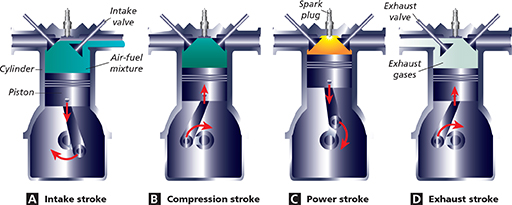Internal Combustion Engine
Most cars use internal combustion engines that burn gasoline. An internal combustion engine is a heat engine in which the fuel burns inside the engine. Most internal combustion engines use pistons that move up and down inside cylinders. Each upward or downward motion of a piston is called a stroke. The linear motion of each stroke is converted into rotary motion by the crankshaft. The crankshaft is connected to the transmission, which is linked to the vehicle's wheels through the drive shaft.
Figure 12 shows the sequence of events in one cylinder of a fourstroke engine. In the intake stroke, a mixture of air and gasoline vapor enters the cylinder. Next, in the compression stroke, the piston compresses the gas mixture. At the end of compression, the spark plug ignites the mixture, which heats the gas under pressure. In the power stroke, the hot gas expands and drives the piston down. During the exhaust stroke, gas leaves the cylinder, and the cycle repeats.
Recall that a heat engine must discharge some waste energy in order to do work. In an internal combustion engine, the cooling system and exhaust transfer heat from the engine to the environment. A coolant— usually water and antifreeze—absorbs some thermal energy from the engine and then passes through the radiator. A fan blows air through the radiator, transferring thermal energy to the atmosphere. Without a cooling system, an engine would be damaged by thermal expansion. If you are ever in a car that overheats, stop driving and allow the engine to cool. Otherwise, there is a risk of serious damage to the engine.
Gasoline engines are more efficient than old-fashioned steam engines, but they still are not very efficient. Only about one third of the fuel energy in a gasoline engine is converted to work. Auto makers have tried several ways to make engines more efficient. One design, called a hybrid design, uses a heat engine together with an electric motor. This design is explained in the How It Works box on the next page.

Figure 12 In an internal combustion engine, fuel is burned inside the engine. Most cars have a four-stroke internal combustion engine. This diagram shows only one of the cylinders during each stroke. Classifying In which of the strokes does the piston do work that can be used by the car?
d




